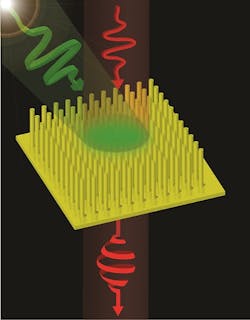King's College achieves ultrafast light polarization change, enabling new applications
Scientists at King's College London have developed a new way to rapidly change the polarization of light, one of its fundamental properties. The research, published in Nature Photonics, could lead to much faster data transfer and advance research into nanomaterials.
RELATED ARTICLE: Chiral metamaterial produces record optical shift under milliwatt-level power changes
The electronic methods currently used to control the light polarization are reaching their physical speed limits. This research overcomes this problem, allowing polarization to be switched at timescales of less than a millionth of a millionth of a second--hundreds of times faster than current electronic methods. This will allow them to see ultrafast nanoscale processes such as chemical reactions for the first time, by illuminating them with rapidly changing light. This helps scientists understand the difference in formation of nasty chemicals and life-saving drugs, and allows the study new materials that will bring about the next technological revolutions.
This will also represent a major advance in data transfer speeds. By rapidly changing the polarization of light--to represent a one or a zero--data can be passed along fiber-optic cables and into your living room more rapidly. This will help meet growing data sharing demands driven by streaming and cloud services.
The team designed nanostructured materials that can control light polarization using light itself--a technique they call all-optical polarization control. These nanostructures are known as metamaterials: materials with optical properties not available in nature. These thin, lightweight materials are constructed from elements smaller than a thousandth of a millimeter in order to create exotic optical effects.
In this case, the metamaterial is constructed of gold nanoparticles. A high intensity light pulse is fired into the metamaterial, injecting energy into electrons in gold particles, which in turn changes the refractive index of the material. A second pulse is fired at the metamaterial at the same time and as this pulse passes through the material, the change in refractive index changes its polarization. This all happens instantaneously, allowing polarization to be changed trillions of times per second.
By simply shining two beams of light through the material, one beam is able to control the polarization of the other at ultrafast speed. The effect can also be observed even with one beam, whereby the polarization of the light beam transmitted through the metamaterial changes with the intensity. This process is similar to Polaroid sunglasses that adjust themselves to remove glare whenever there is too much sunlight.
Luke Nicholls, the PhD student who carried out these experiments, said, "With everybody using more and more data, streaming videos, music and sharing pictures, we are fast approaching a point where the current internet infrastructure will not be able to cope. All-optical control provides an answer to this looming problem and hopefully sees an end to staring at the infuriating buffer wheel."
This research also has potential beyond how many box sets we can download. Control of light at such short time scales could also feed into quantum information processing, where controlling the polarization of light is integral for building successful quantum computing devices. Professor Anatoly Zayats of King's College concludes, "This effect opens up many opportunities for new applications which can directly impact everyday life. The faster you can control light polarisation, the faster you can use light to transmit data and make measurements."
SOURCE: King's College; https://www.kcl.ac.uk/newsevents/news/index.aspx

Gail Overton | Senior Editor (2004-2020)
Gail has more than 30 years of engineering, marketing, product management, and editorial experience in the photonics and optical communications industry. Before joining the staff at Laser Focus World in 2004, she held many product management and product marketing roles in the fiber-optics industry, most notably at Hughes (El Segundo, CA), GTE Labs (Waltham, MA), Corning (Corning, NY), Photon Kinetics (Beaverton, OR), and Newport Corporation (Irvine, CA). During her marketing career, Gail published articles in WDM Solutions and Sensors magazine and traveled internationally to conduct product and sales training. Gail received her BS degree in physics, with an emphasis in optics, from San Diego State University in San Diego, CA in May 1986.
